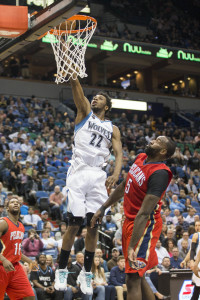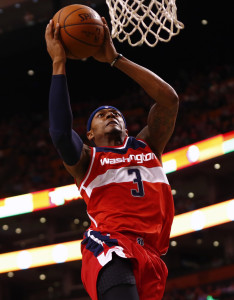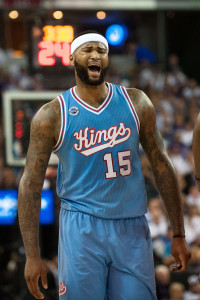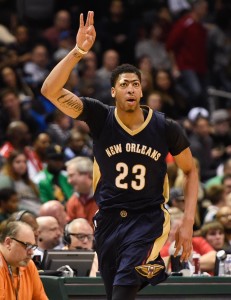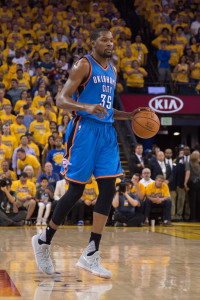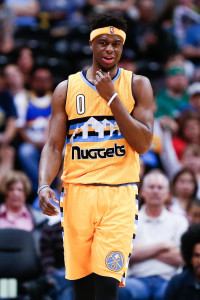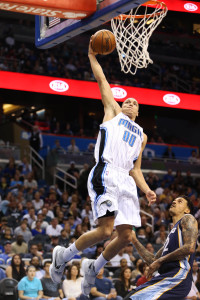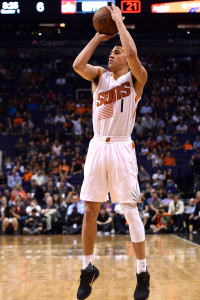Hoops Rumors is looking ahead to offseason moves for all 30 teams. We’ll examine free agency, the draft, trades and other key storylines for each franchise heading into the summer.
State Of The Franchise
At the start of last season, the Timberwolves were in a state of mourning. The sudden death of ex-coach and team executive Flip Saunders cast a pall over the franchise and it was difficult for everyone in the organization to overcome their grief.
As the season moved along, it was clear that Saunders’ blueprint for turning the franchise around was working. His decision to select Karl-Anthony Towns ahead of D’Angelo Russell and Jahlil Okafor with the No. 1 overall pick in last June’s draft accelerated the process toward making the Timberwolves a playoff contender again. Towns quickly established himself as a franchise player, averaging 18.3 points and 10.5 rebounds to earn the Rookie of the Year award.
Several other young players — Andrew Wiggins, Zach LaVine, Shabazz Muhammad and Gorgui Dieng — showed significant development even though Minnesota finished with a 29-53 record.
Owner Glen Taylor decided to shake up the front office and find a high-profile coach to nurture the talented core into reaching its full potential. Interim coach Sam Mitchell was replaced by ex-Bulls coach Tom Thibodeau, who was also given the title of president of basketball operations. Former Spurs assistant GM and longtime Jazz executive Scott Layden was hired as Minnesota’s new GM.
Blockbuster Trade Brewing?
Thibodeau seems intent on getting an established, All-Star-caliber player to pair up with Towns. That was made clear when a report surfaced that the Timberwolves were willing to deal the No. 5 pick as part of a package to acquire Bulls star shooting guard Jimmy Butler.
It’s uncertain whether Chicago would consider moving Butler and go into full rebuild mode. Certainly, the Timberwolves would have to sweeten the pot by giving up one or more of their young assets.
Towns is obviously an untouchable but it’s not out of the question that the Timberwolves would consider moving Wiggins if Thibodeau doesn’t view him as the No. 2 scoring option on a contending team. Wiggins averaged 20.7 points in his second season but he’s not a three-point threat and his defensive box rating of minus 2.5 last season needs to improve dramatically for a defense-oriented coach like Thibodeau.
The club would almost certainly rather part with LaVine and other assets, but that might not be enough to acquire an All-Star entering his prime.
Free Agent Targets
It’s no surprise that unrestricted free agent Joakim Noah has been linked to his former coach.
Noah was unhappy with his playing time last season under first-year Bulls coach Fred Hoiberg before a shoulder injury short-circuited his season. A mobile shot-blocker like Noah would seem to be an ideal fit for a club that finished 28th in defensive field-goal percentage. Though Kevin Garnett is still on the roster, Noah would give the club another veteran leader who would play significant minutes.
The Timberwolves will have anywhere from $26-$29MM to sign other free agents with an eye toward versatile defenders and three-point shooters. The Wolves were 25th in three-point percentage last season and the addition of floor spacers will make Towns an even tougher cover in the post.
Potential Trades
Even if the plan to acquire Butler falls through, the Timberwolves figure to be active in the trade market as Thibodeau tries to reshape his roster.
A couple of Minnesota’s rotation players could be on the move. Point guard Ricky Rubio, who has three years and $42.MM remaining on his contract, would be expendable if Thibodeau isn’t sold on him as his long-term floor leader. LaVine could step into that role, or the Timberwolves could draft a point guard if they keep their pick.
Meanwhile, center Nikola Pekovic‘s career has been sidetracked by injuries and he only appeared in 12 games last season while recovering from Achilles tendon surgery. Pekovic has two years and $23.7MM remaining on his deal, but he’s a proven low-post scorer for a team lacking inside punch.
Another big man, Nemanja Bjelica, was a disappointment in his first season with the club, but was highly sought after during last summer before he signed with the Timberwolves. His remaining contract — two years, $7.75MM — makes him a movable piece.
Draft Outlook
- First-round pick: No. 5
The Timberwolves could go in a lot of different directions if they don’t deal their pick.
They could opt for a wing shooter like Buddy Hield to improve their perimeter game. They could secure one of the top point guards, either Kris Dunn or Jamal Murray, if they’re intent on dealing Rubio. Or they could hone in on a big man such as Marquese Chriss or Dragan Bender to pair up with Towns.
Other Decisions
Muhammad and Dieng are eligible for rookie-scale extensions before next season and it will interesting to see how much the new regime values that duo.
While Muhammad provides instant offense off the bench, he’s a subpar three-point shooter. Dieng is a solid defender — he sports a 2.4 defensive box rating in each of the past two seasons — and Thibodeau can’t get enough of those kinds of players.
Coaching Outlook
In stark contrast to the uncertainty surrounding Mitchell’s future last season, the Timberwolves now have an established playoff coach on a long-term contract. Thibodeau signed a five-year, $40MM deal and his front-office title makes him the unquestioned leader of the franchise.
The addition of Layden echoes what the Pistons did when hiring Stan Van Gundy with the same titles as Thibodeau. Detroit added a proven front-office executive in Jeff Bower to negotiate trades and handle most of the day-to-day front office operations. Thibodeau will work in concert with Layden, but the former Bulls coach will have the final say.
Final Take
The Timberwolves look a lot like the Thunder several years ago. They have star talents in Towns and Wiggins, a la Kevin Durant and Russell Westbrook, to build around. With Thibodeau in charge, they’re ready to take the next step. If they can pull off a blockbuster and pry an proven, top-tier talent away from a team looking to shake up its roster, the Wolves could find themselves in the playoffs next season.
Guaranteed Salary
- Ricky Rubio ($13,400,000)
- Nikola Pekovic ($12,100,000)
- Kevin Garnett ($8,000,000)
- Andrew Wiggins ($6,006,600)
- Karl-Anthony Towns ($5,960,160)
- Nemanja Bjelica ($3,800,000)
- Shabazz Muhammad ($3,046,299)
- Gorgui Dieng ($2,348,783)
- Zach LaVine ($2,240,880)
- Adreian Payne ($2,022,240)
- (Kevin Martin $1,380,305) — Salary remaining from release via stretch provision
- Tyus Jones ($1,339,680)
- Total: $61,644,947
Player Options
- None
Team Options
- Damjan Rudez ($1,199,000)
Non-Guaranteed Salary
- Greg Smith ($1,139,123)
Restricted Free Agents (Qualifying Offers/Cap Holds)
- None
Unrestricted Free Agents (Cap Holds)
- Tayshaun Prince ($980,431)
Other Cap Holds
- No. 5 pick ($3,227,100)
- Justin Hamilton ($980,431)
- Robbie Hummel ($980,431)
- Othyus Jeffers ($980,431)
- Arinze Onuaku ($980,431)
- Total: $7,148,824
Projected Salary Cap: $92,000,000
The Basketball Insiders salary pages were used in the creation of this post.
